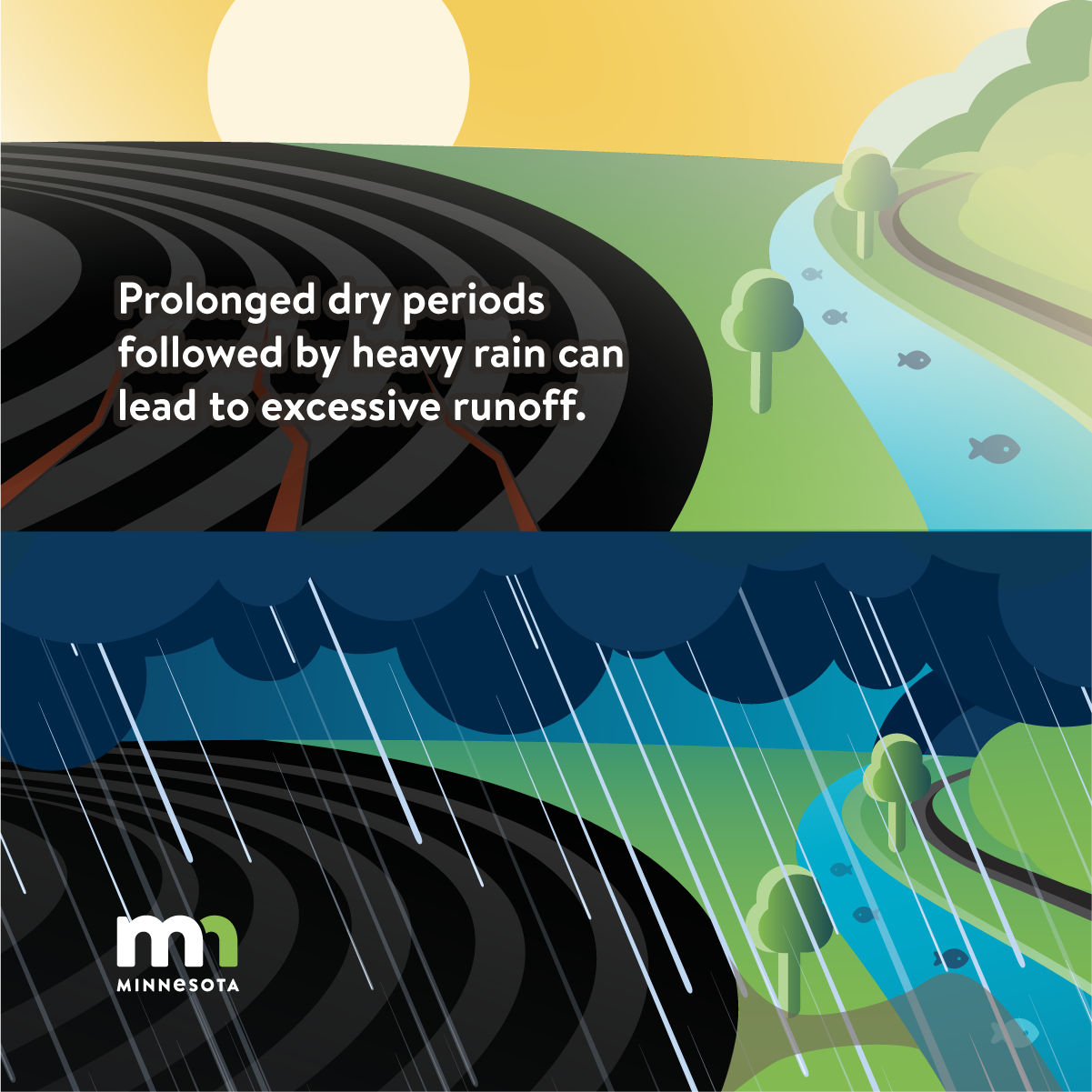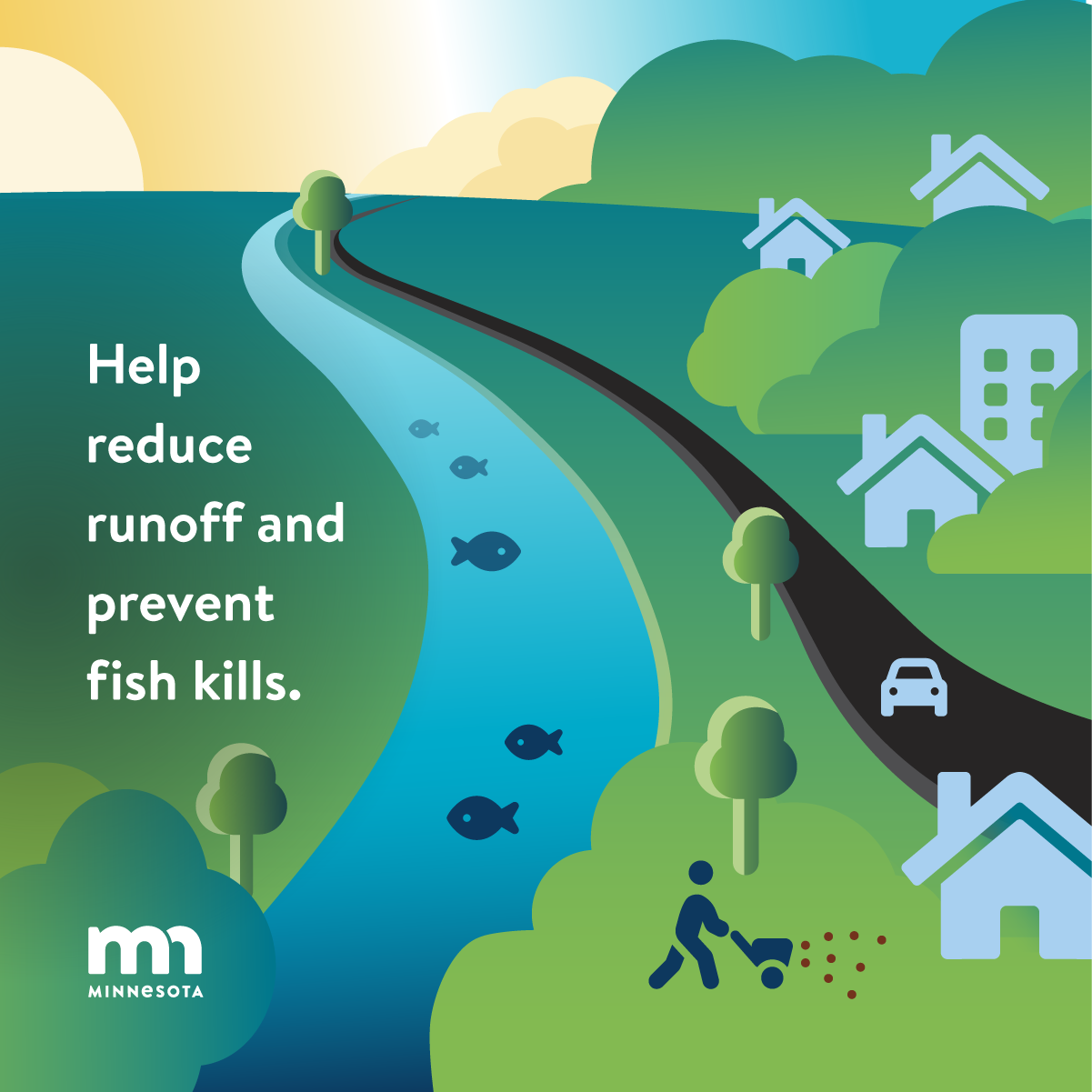Reducing pollutant runoff can protect water and fish!
Agriculture:
Agriculture is an essential part of Minnesota and our rural communities. Farmers feed us, fuel our cars, and drive our economy — all through long days and a short growing season. Windows for applying manure and pesticides can be short, making application timing difficult.
Smart application of manure, pesticides, and fertilizers is critical to maximize their value and increase crop productivity. Runoff from fields not only reduces crop productivity but may also impact water quality and could contribute to fish kills, especially when applied improperly or too close to rain events.
Application tips to reduce runoff
- Forecast: When rain is forecast, do not apply. Use caution when applying to saturated soil. The Minnesota Department of Agriculture’s Runoff Risk Advisory Forecast tool can help determine the best time to apply.
- Location: Observe all applicable setbacks to surface waters and sensitive areas. Pay special attention to areas of your fields where water flows after rain or snow melt. Stay clear of steep slopes and surface water locations, such as rivers, streams, or sinkholes and wetlands.
- Rate: Follow labels to ensure proper application rates. Use the University of Minnesota Extension’s manure management website to calculate the best rates for your fields.
- Method: Reduce nutrient loss by selecting the best application method for your manure and chemicals and incorporate them into the soil immediately to decrease evaporation and runoff.
Visit the MPCA’s website to learn more about best management practices for land application of manure.
If runoff does happen, report it to the Minnesota Duty Officer at 1-800-422-0798. Keep the information basic and give the officer your location. The duty officer will contact local authorities.
Extreme weather magnifies everything.
Minnesota’s weather is changing: We’re getting warmer and wetter. Strong storms following long dry periods can increase the risk for fish kills in streams. These weather transitions from extreme wet to dry are also happening more quickly and more frequently, making the timing of any applications that much more critical. Rains can wash away valuable nutrients and pollute downstream waters.
Runoff doesn’t just impact fish.
Runoff may impact drinking water in private and community wells. Geographic land features in southeast Minnesota, such as karst, can deliver pollutants to groundwater through sinkholes and fractured bedrock. Learn more about well testing at the Minnesota Department of Health’s website.
Farming is difficult, but your dedication to the land and water makes Minnesota a great place to live, work and play. Use the weather forecast as your guide and avoid applications before rainstorms. Learn more at pca.state.mn.us/fishkills.
Report any spill, runoff, or fish kill 24/7 by calling the Minnesota Duty Officer at 1-800-422-0798.
Homeowners:Everyone has a role to play to reduce pollution runoff into lakes, streams, and groundwater — from private homeowners and cabin residents to small family farmers and larger agricultural operations. The following tips will help protect drinking water from private and community wells, prevent fish kills, and maximize soil and crop quality.
- To minimize pollution in residential areas, homeowners should minimize using lawn chemicals and avoid applying any lawn chemicals before rain, keep septic systems operating properly and dispose of household waste correctly.
- To protect lakes, rivers, and streams, shoreland owners should plant trees or deep-rooted native plants to slow, trap, or reduce pollutants that may leave the land and flow to waterways during rain events.
- To maximize benefits to crops and minimize negative impacts on water resources, farmers should use best management practices when applying manure and chemicals to fields. Manure and chemicals are important assets that increase crop productivity, but when applied before rains, field runoff pollutes water.
Runoff may impact drinking water in private and community wells. Geographic land features in southeast Minnesota, such as karst, can deliver pollutants to groundwater through sinkholes and fractured bedrock. Learn more about well testing at the Water Quality/Well Testing/Well Disinfection page on the Minnesota Department of Health website.
Minnesota’s weather is changing: We’re getting warmer and wetter. Strong storms following long dry periods can increase the risk for fish kills in streams. Rains can wash away valuable nutrients and pollute downstream waters. Watch the weather and avoid applying fertilizers, chemicals, and manure before rainstorms.
Report any spill, runoff, or fish kill 24/7 by calling the Minnesota Duty Officer at 1-800-422-0798. The Minnesota Pollution Control Agency (MPCA), Department of Natural Resources (DNR), and Department of Agriculture (MDA) coordinate on fish kill responses.
Talk to neighbors and do your part to preserve and protect water quality. Learn more at pca.state.mn.us/fishkills.
Pull out: Fish kills can be caused by disease, changes in water quality, weather, water temperatures, water levels, and external sources, such as polluted runoff. There are often multiple factors that combine to cause a fish kill.


